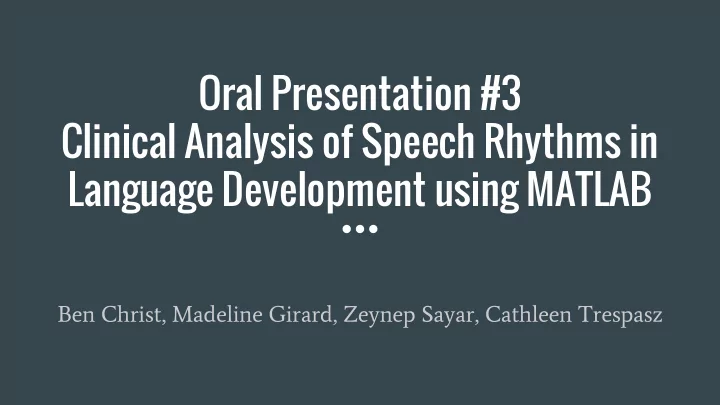

Oral Presentation #3 Clinical Analysis of Speech Rhythms in Language Development using MATLAB Ben Christ, Madeline Girard, Zeynep Sayar, Cathleen Trespasz
Problem Statement Preliminary research has been conducted that indicates a correlation exists between an individual’ s rhythmic capabilities and language development. Currently, the data analysis process used to determine an individual’s rhythmic abilities is inefficient and impractical in a clinical setting. No data analysis process or system exists to assess an individual’s speech rhythm. There is a need in the industry for a diagnostic technique that efficiently analyzes the individual’s recorded speech to determine whether their rhythm is considered good or bad. There is an immediate need in the Gordon lab for a data analysis process that quickly and efficiently judges rhythm in speech. Beyond the Gordon lab, there is a clinical need for a device with an intuitive interface that is capable of immediate analysis and display of feedback
Needs Assessment ● Must: ○ Detect the rhythm of the English language. ○ Detect the rhythm of musical metronomes. ○ Compare rhythms of English language and music. ● Data collected from instrument should be stored for analysis and future retrieval. ● Design must not exceed NIH grant budget. ● Instrument must be safe , physically compatible with children, and comfortable . ● Design must allow for variability between patient speech and disorders. ● Lab setting must induce positive reinforcement for child compliance. ● Must be compatible with data files of past research.
Updated Needs Assessment ● Must streamline data in one software program ● Must reduce time needed to analyze data ● Must use consistent analytics ● Must provide feedback to user and lab staff ● Must have intuitive interface
Specific Language Impairment and Lab Data ~75% of SLI goes undiagnosed ● SLI prevalence: about 7% of kindergartners ● Potential subjects are found from pediatric speech clinics, flyers, and word of ● mouth How are subjects chosen for the study? ● Potential subjects have screening visits to quantify language skills ○ Occurs by administering the SPELT-3 exam ○ This data excludes late talkers and untrue SLI ○ Often is comorbid with dyslexia ●
Manifestation of SLI Here we see the differences in self synchrony between a good and a poor synchronizer. While these graphs are not from and SLI patient and a healthy patient. We expect that SLI patients will have data that more closely represents the bottom graph.
Design Components MATLAB program: ● Collect and analyze speech and metronome tracks ○ Utilization of toolbox functions and circular statistics ○ Feedback and user interface to assess patient rhythm consistency and accuracy ○ Data analysis program must be compatible with: ● Various computer operating systems ○ ○ A microphone (SM 58) Headphones (any brand) ○ ○ External Soundcard (Scarlett 2i2 system) The design of the study will: ● Determine the rhythm baseline by sampling a population of individuals with normal speech ○ development Longitudinally assess impact of musical training on speech rhythm therapy ○
Meeting with Dr. Nori Jacoby •Tuesday January 26 th 2016- Research Fellow at MIT •We discussed: -The difference between using the onset of the syllable versus using 60% of the speech beat amplitude -The root cause of lag and latency using a PC’s sound card -Resampling data in order to change sampling frequency to 44,100Hz -Equipment: sound cards, cables and microphones
Latency and Lag
Pre Soundcard Latency Lag correction
Soundcard Application working diagram Scarlett 2i2 Soundcard Input 2 - The recording of Input 1 the patient
MATLAB code outline Import data into MATLAB- ✓ ● Create visual display of data- ✓ ● Filter data- ✓ ● Locate speech beat peaks- ✓ ● Locate speech beat 60% onsets ● Import data into past circular statistics code ● Edit circular statistics code ● Output of diagnostic metrics ●
New Filtering
Immediate/Near Future Work Identify 60% up the waveform ● Export 60% waveform data into circular statistics code ● Test and report on the effects of the new sound capture system ● Continue work on the grant proposal ●
Questions & Comments
Recommend
More recommend